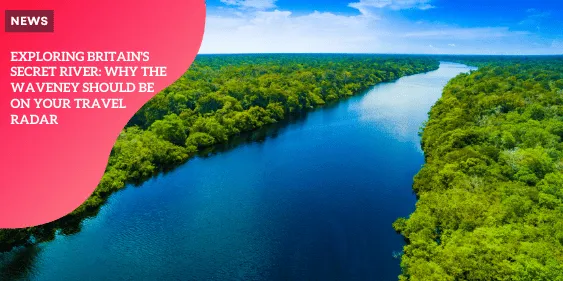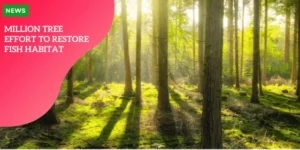Exploring Britain’s Secret River: Why the Waveney Should Be on Your Travel Radar

Stretching 59 miles along the Norfolk-Suffolk border, the River Waveney offers a hidden haven of natural beauty and historical richness.
Despite being celebrated in Roger Deakin’s influential book “Waterlog,” which sparked Britain’s wild swimming movement, most Brits remain blissfully unaware of this scenic waterway.
The Waveney begins its journey at Redgrave and Lopham Fen, meandering through East Anglia before merging with the River Yare and eventually reaching the sea at Great Yarmouth.
Along its banks, visitors can find thriving habitats for otters, kingfishers, and water voles.
Immortalized in Deakin’s book, the Waveney holds a special place in the hearts of wild swimming enthusiasts.
Deakin canoed down this river, recounting his trips vividly in “Waterlog” and a radio piece for the BBC.
The Waveney’s willow-shaded bends and secret pools make it an enchanting escape route into the wild, untamed beauty of East Anglia.
A journey along the Waveney reveals a slow-paced, romantic allure, perfect for those looking to reconnect with nature.
The Waveney’s Historical Significance
Role in Britain’s Wild Swimming Movement
The River Waveney has an illustrious role in Britain’s wild swimming movement, greatly celebrated in Roger Deakin’s influential book, “Waterlog.”
Deakin’s love for the Waveney is palpable; he described the river as an “escape route” into another world.
His regular swims in this 59-mile waterway fueled the creation of “Waterlog,” a seminal work that advocated for the right to swim in natural waters.
Historic Drainage Mills and Their Importance
A distinct feature of the Waveney’s landscape is its historic drainage mills.
These mills once played a crucial role in draining the surrounding marshlands, making the area suitable for agriculture.
They stand today as sentinels, embodying the region’s past.
While some mills have succumbed to time and nature, others still loom large, particularly in winter when they appear ghost-like amidst the morning mist.
Rich Wildlife Habitat
The Waveney is a sanctuary for various wildlife species.
Otters can often be spotted sunning themselves on floating logs, while kingfishers dart across the water, their brilliant blue feathers catching the eye.
Water voles, increasingly rare in other parts of the UK, find refuge along its banks.
Deakin’s encounters with this rich wildlife only deepened his reverence for the river, making it a recurring theme in his writings and radio features.
Efforts to protect these habitats are ongoing, ensuring that future generations can enjoy the same diverse array of flora and fauna.
With its historical significance and abundant wildlife, the Waveney is more than just a river—it’s a living testament to Britain’s natural and cultural heritage.
Natural Beauty and Seasonal Changes
The River Waveney offers a picturesque journey through East Anglia, transforming with each season.
Its scenic landscapes promise a different charm throughout the year, making it a perfect getaway for nature enthusiasts.
Scenic Landscapes Throughout the Year
Winter cloaks the Waveney with an enchanting, almost mystical charm.
The ghost-white drainage mills rise like sentinels, and the reeds stiffen with frost, creating a serene and quiet atmosphere.
As spring arrives, fluffy pussy willow seeds float gently on the water, resembling the softest of snow, and nature begins to awaken with vibrant colors and sounds.
Summer brings an orchestra of bird chatter and blooming hedges, while autumn drapes the landscape in warm hues and tranquil reflections.
Unique Features: Secret Pools and Sandy Beaches
The Waveney is dotted with unique features that beckon explorers.
Secret pools and sandy beaches are scattered along its course, offering hidden spots perfect for a serene dip or a peaceful picnic.
These natural treasures are beautifully described in Roger Deakin’s “Waterlog,” where he fondly refers to the river as his escape into another world.
Diverse Flora and Fauna Along the River
The riverbanks of the Waveney are home to a diverse range of flora and fauna.
Otters playfully dart in and out of the water, kingfishers flash their vibrant colors as they dive for fish, and water voles scuttle along the banks.
The river supports an ecosystem teeming with life, from aquatic plants to a variety of bird species, creating a natural haven for wildlife enthusiasts.
Each season paints the Waveney in new shades, offering endless opportunities to connect with nature.
Whether you’re cycling along its gentle curves or taking a quiet stroll by its banks, the Waveney’s ever-changing beauty captivates the heart and soul.
Exploring the Waveney: Activities and Attractions
Cycling and Walking Routes
The River Waveney offers an idyllic setting for cycling and walking enthusiasts.
The landscape is largely free from heavy development, letting you glide alongside the water almost uninterrupted.
My partner and I cycled from Hertfordshire, tracing 104 miles of gentle river valleys over four days, making stops at charming B&Bs.
Notable highlights include the route through Oulton Broads, dotted with marshlands and cylindrical monuments.
Wild Swimming and Kayaking Opportunities
Wild swimming is central to the Waveney experience, with secret pools and sandy beaches awaiting discovery.
Inspired by Roger Deakin’s famous swims, visitors can revel in invigorating dips and even encounter wildlife.
Paddling a kayak from Redgrave and Lopham Fen to the Geldeston Locks introduces you to the timeless beauty of the region and its thriving inhabitants, like otters and kingfishers.
Historic Sites and Charming Villages
Exploring the Waveney also means delving into its rich history. Somerleyton village presents a memorable sight with the Herringfleet smock drainage mill—the oldest on the Broads.
Nearby Bungay is an enigmatic village steeped in the legend of the Bungay Black Dog and home to indie shops and a 12th-century castle.
The white weather-boarded Geldeston Lock Inn offers live music and a glimpse into the area’s historical significance.
From charming walks to serene swims, the River Waveney offers various engaging activities as you explore its untamed beauty.
Make sure to experience the vibrant local culture to truly immerse yourself in what this hidden gem has to offer.
Cultural and Culinary Experiences
Local Craft Breweries and Indie Cafes
One of the absolute joys of exploring the River Waveney is stumbling upon its charming craft breweries and indie cafes.
These local gems offer a delicious taste of the region, each one with its own unique flair.
Start your journey at Ampersand Brew Co.
In Harleston, which serves up inventive craft beers like the refreshing Bidon pale ale and the summery Basil Blush with raspberry.
A stop here provides not only a great pint but a glimpse into the area’s burgeoning craft beer scene.
Continuing your exploration of local flavors, the Waveney Valley’s indie cafes are equally delightful.
For a caffeine fix, head to Bungay, known for delicious brews and inviting atmosphere at places like Earsham Street Café.
The Ethiopian coffee at this café will give you the energy for your next adventure along the river.
Historic Pubs and Inns Along the Route
The River Waveney is dotted with historical pubs and inns that tell the tales of yesteryears while serving up some of the best ales and traditional fare.
One such place is the Geldeston Lock Inn, famed for its live music and warm ambiance. It’s a perfect stop after a day of kayaking or cycling to unwind with a pint in hand.
Further up the river, the historic Fleece Inn in Bungay invites visitors with its 16th-century charm.
A night here allows you to experience centuries of history along with delectable meals and rich local ales.
The building’s beamed interiors and comforting food make for an unforgettable dining experience.
Unique Attractions: The Bungay Black Dog Legend
No journey along the Waveney would be complete without delving into the lore that enriches the area.
Among these, the legend of the Bungay Black Dog, or Black Shuck, stands out.
This ghostly hound is said to have haunted the town of Bungay for centuries, making appearances that chill the spine of even the bravest souls.
The town commemorates this eerie legend with various nods, including the Black Dog Running Club.
A statue invites visitors to ponder over tales of this mysterious creature as they explore Bungay’s indie shops and take in the historic atmosphere.
Explore these cultural and culinary delights along the River Waveney to truly understand the area’s unique charm and character.
Planning Your Waveney Adventure
Recommended Itineraries for Cycling or Walking
The River Waveney’s landscape is a cyclist’s dream with its gently undulating terrain and scenic vistas.
Start your journey from Diss railway station, a convenient access point, and chart a 104-mile route over four days.
Pass through idyllic villages like Bungay and Beccles.
For walkers, the Angles Way offers a rewarding path aligned to the river at points, stretching from Knettishall Heath to Great Yarmouth.
Enjoy tranquil pauses at willow-shaded bends and historic drainage mills.
Accommodation Options and Luggage Transfer Services
Comfortable accommodations range from quaint bed and breakfasts to cozy inns.
The Black Dog Freehouse in Bungay provides a unique historical ambiance, while The Fleece Inn offers both hospitality and a peek into local lore.
For added convenience, consider services like Bikeline, which transfers your luggage between accommodations.
Best Times to Visit and Safety Considerations
The Waveney offers something special in every season: sunny swims in summer, fiery foliage in fall, and the stark beauty of frosty winters.
Aim for late spring through early autumn for optimal weather conditions.
Be mindful of local wildlife, respectful of private land, and avoid swimming in the river 48 hours after heavy rainfall to ensure safety from pollution runoff.
Planning a trip to the River Waveney immerses you in a tranquil, untamed world where history and nature converge.
The Waveney’s Future and Conservation
Efforts to Preserve the River’s Natural Beauty
The River Waveney’s serene beauty and rich biodiversity have inspired extensive conservation efforts.
One of the main goals is to maintain the idyllic landscapes and historical features that make the Waveney so special.
Organizations and local volunteers work together to clean the riverbanks, plant native species, and restore habitats.
The historic drainage mills, like the Herringfleet smock drainage mill, are preserved to maintain the river’s historical charm.
Importance of Responsible Tourism
Tourism plays a significant role in the future of the Waveney, but it must be done sustainably.
As more travelers discover this hidden gem, responsible tourism has become crucial.
Visitors are encouraged to respect wildlife, stay on designated paths, and dispose of waste properly.
By doing so, they help minimize human impact on the delicate ecosystems and ensure the river remains unspoiled for future generations.
Ongoing Initiatives to Protect Wildlife and Water Quality
To protect the diverse species inhabiting the Waveney, several ongoing initiatives focus on preserving water quality and wildlife habitats.
Efforts include monitoring pollution levels, promoting organic farming practices nearby, and improving sewage treatment facilities to reduce harmful runoffs.
Conservationists also engage in projects to support the river’s iconic species like otters, kingfishers, and water voles, further enhancing biodiversity along the Waveney.
As we cherish and preserve the Waveney, we invite everyone to contribute to its protection. Explorers will find much joy in discovering the river’s untamed charm.





